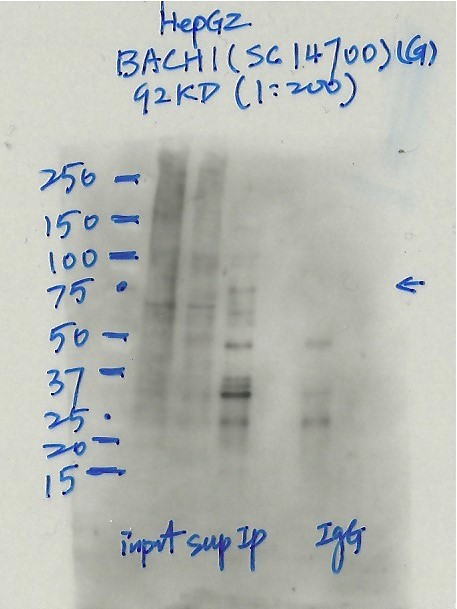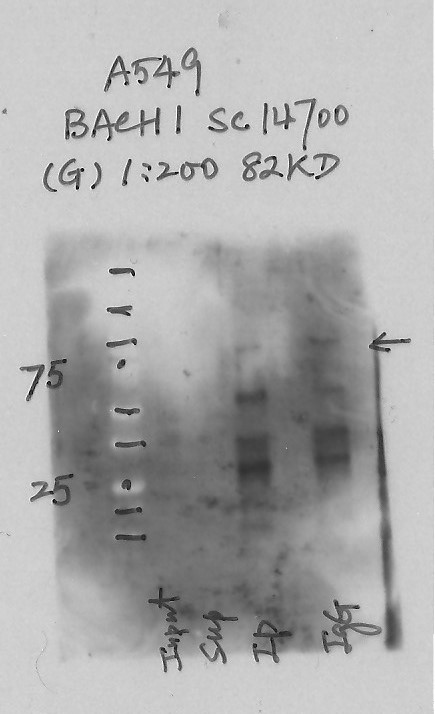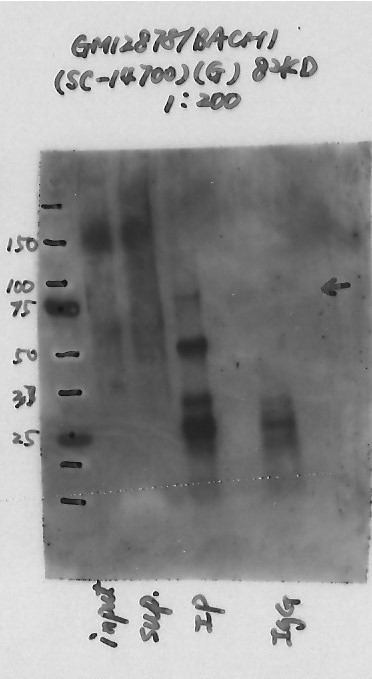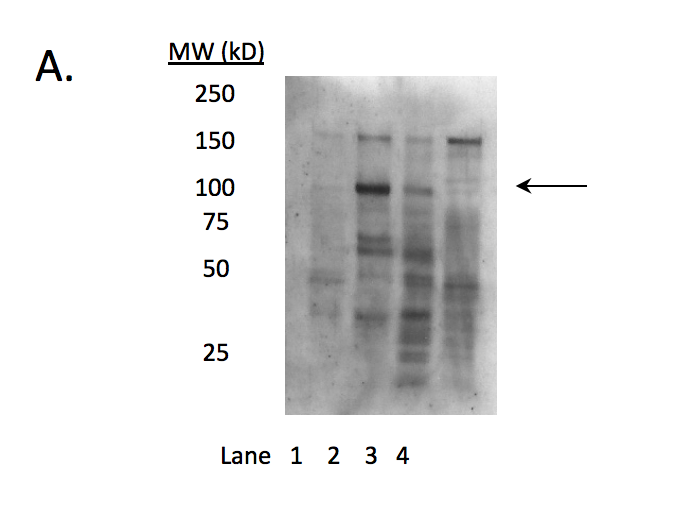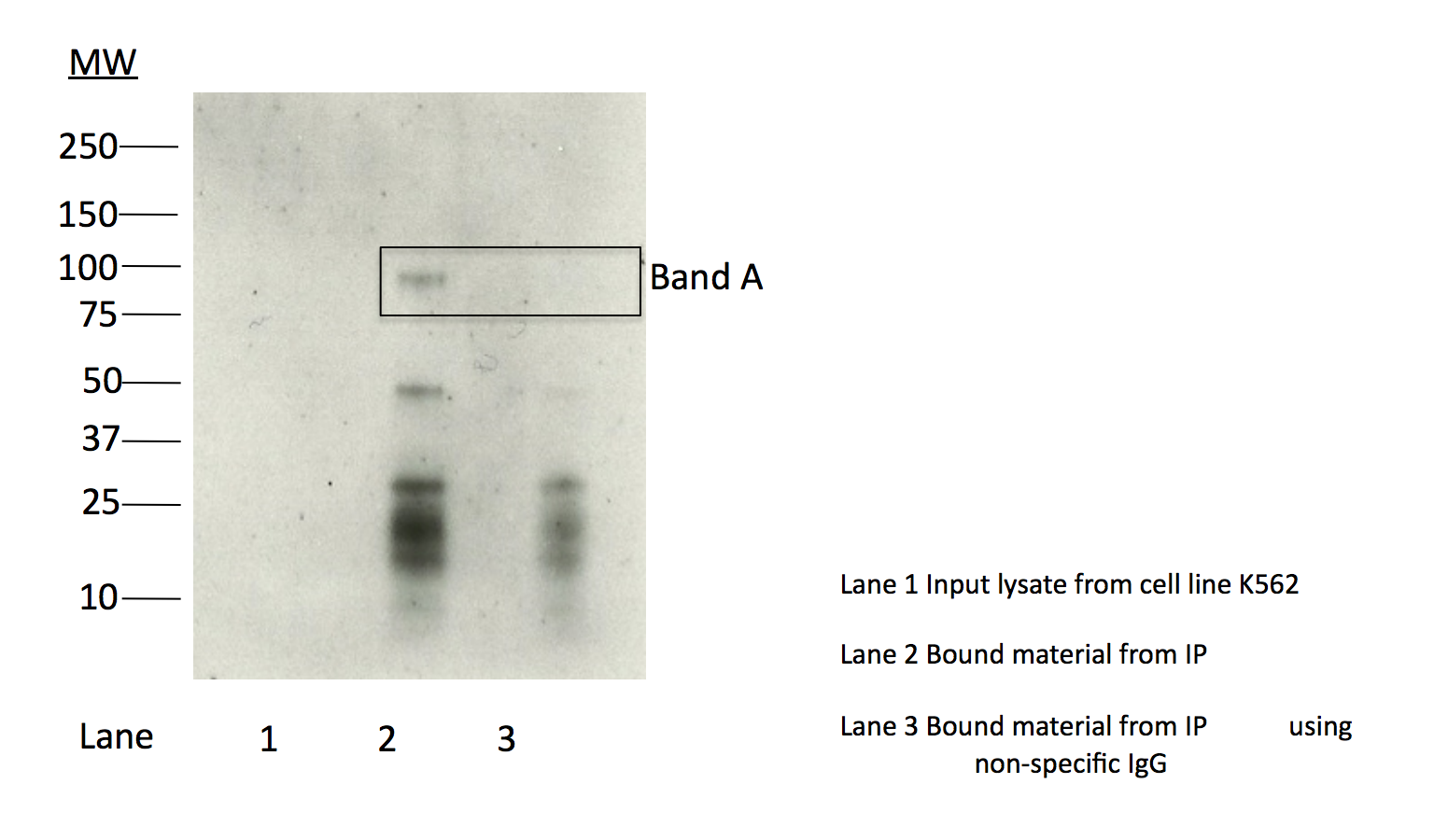ENCAB000AEA
Antibody against Homo sapiens BACH1
Homo sapiens
GM12878, K562
characterized to standards
Homo sapiens
any cell type or tissue, A549
partially characterized
Homo sapiens
HeLa-S3, HepG2
not characterized to standards
- Status
- released
- Source (vendor)
- Santa Cruz Biotech
- Product ID
- sc-14700
- Lot ID
- E1503
- Characterized targets
- BACH1 (Homo sapiens)
- Host
- goat
- Clonality
- polyclonal
- Purification
- affinity
- Antigen description
- Raised against a peptide mapping near the C-terminus of BACH1 of human origin.
- External resources
Characterizations
BACH1 (Homo sapiens)
HepG2
not compliant
- Caption
- Immunoprecipitation was performed on nuclear extracts from the cell line: HepG2, using the antibody sc-14700. The blot shows western blot analysis of input, flowthrough, immunoprecipitate and mock immunoprecipitate using IgG.Molecular Weight: None
- Reviewer comment
- KCO: Conflicting image; molecular weight on image states it's 92 kDa, but other cell lines have it at 82 kDa. Provide correct molecular weight. There are also multiple bands with the marked band not > 50% of total signal in the lane.
- Submitted by
- Nathaniel Watson
- Lab
- Michael Snyder, Stanford
- Grant
- U54HG006996
- Download
- #1132 HepG2 BACH1(sc14700) (2).jpg
BACH1 (Homo sapiens)
A549
not submitted for review by lab
- Caption
- Immunoprecipitation was performed on nuclear extracts from the cell line: A549 using the antibody sc-14700. The image shows western blot analysis of input, flowthrough, immunoprecipitate, and mock immunoprecipitate using IgG. Target molecular weight: 82.
- Submitted by
- Nathaniel Watson
- Lab
- Michael Snyder, Stanford
- Grant
- U54HG006996
- Download
- #1147 A549 BACH1sc14700.jpg
BACH1 (Homo sapiens)
Method: immunoprecipitation followed by mass spectrometry
compliant
- Caption
- The gel was silver-stained, gel fragments corresponding to the bands indicated were excised and destained using the SilverSNAP Stain for Mass Spectrometry (Pierce). Then proteins were trypsinized using the in-gel digestion method. Digested proteins were analyzed on an LTQ-Orbitrap (Thermo Scientific) by the nanoLC-ESI-MS/MS technique. Peptides were identified by the SEQUEST algorithm and filtered with a high confidence threshold (Protein false discovery rate < 1%, 2 peptides per protein minimum). Based on these observations, the major band is likely due to the presence of immunoprecipated Bach1 and sc14700 meets the ENCODE standard for validation by this criterion.
- Submitted by
- Michael Snyder
- Lab
- Michael Snyder, Stanford
- Grant
- U54HG004558
- Download
- BACH1_final_AEA Sheet1.pdf
BACH1 (Homo sapiens)
GM12878
compliant
- Caption
- Immunoprecipitation was performed on nuclear extracts from the cell line: GM12878, using the antibody sc-14700. The blot shows western blot analysis of input, flowthrough, immunoprecipitate and mock immunoprecipitate using IgG.Molecular Weight: 82 kDa.
- Submitted by
- Nathaniel Watson
- Lab
- Michael Snyder, Stanford
- Grant
- U54HG006996
- Download
- GM12878-BACH1.jpg
BACH1 (Homo sapiens)
Method: immunoprecipitation followed by mass spectrometry
not reviewed
- Caption
- Immunoprecipitation of Bach1 from K562 cells using sc14700. Lane 1: input nuclear lysate, Lane 2: material immunoprecipitated with ab87525, Lane 3: material immunoprecipitated using control IgG. Band A was excised from the gel and subject to analysis by mass spectrometry. IP followed by mass spectrometry: Briefly, K562 whole cell lysates were immunoprecipitated using sc14700, and the IP fraction was loaded on a 10% polyacrylamide gel (NuPAGE Bis-Tris Gel) and separated with an invitrogen NuPAGE electrophoresis system. The gel was silver-stained, gel fragments corresponding to the bands indicated were excised and destained using the SilverSNAP Stain for Mass Spectrometry (Pierce). Then proteins were trypsinized using the in-gel digestion method. Digested proteins were analyzed on an LTQ-Orbitrap (Thermo Scientific) by the nanoLC-ESI-MS/MS technique. Peptides were identified by the SEQUEST algorithm and filtered with a high confidence threshold (Protein false discovery rate < 1%, 2 peptides per protein minimum). Based on these observations, the major band is likely due to the presence of immunoprecipated Bach1 and sc14700 meets the ENCODE standard for validation by this criterion.
- Submitted by
- Michael Snyder
- Lab
- Michael Snyder, Stanford
- Grant
- U54HG004558
BACH1 (Homo sapiens)
Method: immunoblot
not reviewed
- Caption
- In an immunoblot probed with sc14700, we observe a major band consistent with the expected size of Bach1 (82kD) cell line K562 (lane 2). This band is absent from cell lines GM12878 and HepG2, and is present in lower levels in HeLa S3 cells. This band is specifically immunoprecipitated from K562 cells (see second validation documentation). Mass spectrometry analysis verified the presence of Bach1 as the major component of this band. Therefore, sc14700 meets this criterion for validation.
- Submitted by
- Michael Snyder
- Lab
- Michael Snyder, Stanford
- Grant
- U54HG004558
BACH1 (Homo sapiens)
GM12878K562HeLa-S3HepG2
compliant
- Caption
- In an immunoblot probed with sc14700, we observe a major band consistent with the expected size of Bach1 (82kD) cell line K562 (lane 2). This band is absent from cell lines GM12878 and HepG2, and is present in lower levels in HeLa S3 cells. This band is specifically immunoprecipitated from K562 cells (see second validation documentation). Mass spectrometry analysis verified the presence of Bach1 as the major component of this band. Therefore, sc14700 meets this criterion for validation.
- Reviewer comment
- Major band not >50% in lanes 1, 3, and 4
- Submitted by
- Michael Snyder
- Lab
- Michael Snyder, Stanford
- Grant
- U54HG004558
BACH1 (Homo sapiens)
K562
compliant
- Caption
- Immunoprecipitation of Bach1 from K562 cells using sc14700. Lane 1: input nuclear lysate, Lane 2: material immunoprecipitated with ab87525, Lane 3: material immunoprecipitated using control IgG. Band A was excised from the gel and subject to analysis by mass spectrometry. IP followed by mass spectrometry: Briefly, K562 whole cell lysates were immunoprecipitated using sc14700, and the IP fraction was loaded on a 10% polyacrylamide gel (NuPAGE Bis-Tris Gel) and separated with an invitrogen NuPAGE electrophoresis system.
- Submitted by
- Kathrina Onate
- Lab
- Michael Snyder, Stanford
- Grant
- U54HG004558
